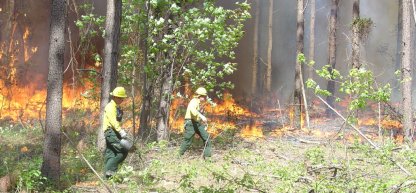Alternatives to fire, such as mechanical, mowing, grazing or chemical do not have the same ecological effects. For example, none of these things can properly kill diseases and pests on the ground, nor do they consume all the combustible materials.

There is a general rule that big fires decrease biological diversity, since only a few species can stand being totally annihilated. Big fires will also tend to impact areas where fire is less useful. A beech forest, for example, will be destroyed by a big fire, but the moist conditions of such a stand will usually resist or limit small fires. Small regular fires lead to greater diversity, since they prevent to domination of a few species while not destroying too much and opening the landscape to some sunlight. In any case, you really cannot avoid fires; you can only postpone them. When combustible materials build up in wild lands, you eventually get a much bigger and more disastrous fire. These are the kind of thing we saw in Yellowstone back in the 1980s. Years of fire exclusion made the place a tinderbox.

An unplanned fire is significantly more dangerous than a prescribed fire, but fire is dangerous no matter what. A prescribed fire can get out of hand and even if it goes 100% according to plan, it will create side effects, principally smoke, that will annoy the neighbors. They say an ounce of prevention is worth a pound of cure. In the case of prescribed fire, an ounce of prevention is sometimes worth a ton of blame, as people weight the tangible effects they see from the prescribed fire with the much greater, but unspecified effects from a true wild fire.
A form for a burn plan is included at this link.
Fire has several simple characteristics. We all know about them, but it is useful to think about what that means. Fire usually rises. You should always avoid getting above a fire. Fire will move up hill more readily than it goes downhill. It will also climb if there is a burnable ladder of brush or branches. Flames will also rise when two fires come together. This may scorch tree branches or even set them on fire. Fire more easily spreads to loose and dry material, but it burns longer in denser materials. You can see that with a campfire. I have seen people trying to light big logs with matches. It doesn’t work. You need to go from the small to the large. Of course, if you light a pile of pine needles with nothing else, you will just have a short flash and then ash.
The behavior of a fire on the ground depends on lots of factors, none of which can be predicted with absolute certainty. The most capricious is the wind. Wind directions can change and local conditions can change the direction locally. The fire itself changes wind conditions. A fire draws in air. If the fire is going up a canyon, it might create an effect much like a chimney.
Other factors include humidity, temperature, air stability and time of day. Higher humidity dampens fire. The key factor is not humidity itself as much as relative humidity. Warm air hold more water than cool air. The same amount of water will be a lot less dense in warm air. Roughly speaking, for every 20 degrees in temperature, the relative humidity decreases by half. That is one reason time of day makes such as difference. You might have dew in the morning (relative humidity is 100% and the air cannot hold the water it has, so dew forms), but as the temperature rises, relative humidity falls. That is why fires burn faster and stronger at 3pm than they do at 3am. Temperature makes a difference independent of humidity, since the cooler the temperature, the more heat a fire needs to generate to maintain and spread.
Fire weather forecasts are available at this link.
You can sometimes see stable air at a distance because may be clearly demarcated layers of air. Stability makes a bigger difference for smoke. In stable air, smoke rises and then flattens out. It doesn’t blow away. Smoke rises higher and disperses easier in unstable air, but unstable air has its own challenges in that it usually has stronger and more variable winds, making fire control more of a challenge. The tradeoff is between smoke problem and fire control problems.
Fire escape used to be the big concern for burn bosses; now it is smoke. As more people w/o country experience move into the countryside, the complains and problems of smoke increase.
Smoke doesn’t always rise. In stable air or in humid condition, it tends to drain. Like water, it drains into valleys and gullies, where it might sit a long time. Unfortunately, valleys are often places where we have roads and homes. Smoke can be a health and a traffic hazard. The worst is “super fog”. Super fog is a combination of smoke and fog that makes visibility almost zero. The fog helps hold the smoke near the ground and the smoke helps keep the fog from evaporating off. It is bad all around.
We used to have lots of super fog in Krakow. We would often unwisely drive in it, following the taillights of the car in front. Such behavior sometimes led to spectacular accidents involving many vehicles. One vehicle stops and the others blindly drive into it, sometimes for miles.
Anyway, those are some of the concerns about prescribed burns. Tomorrow I will talk a little more re how and why we burn.
